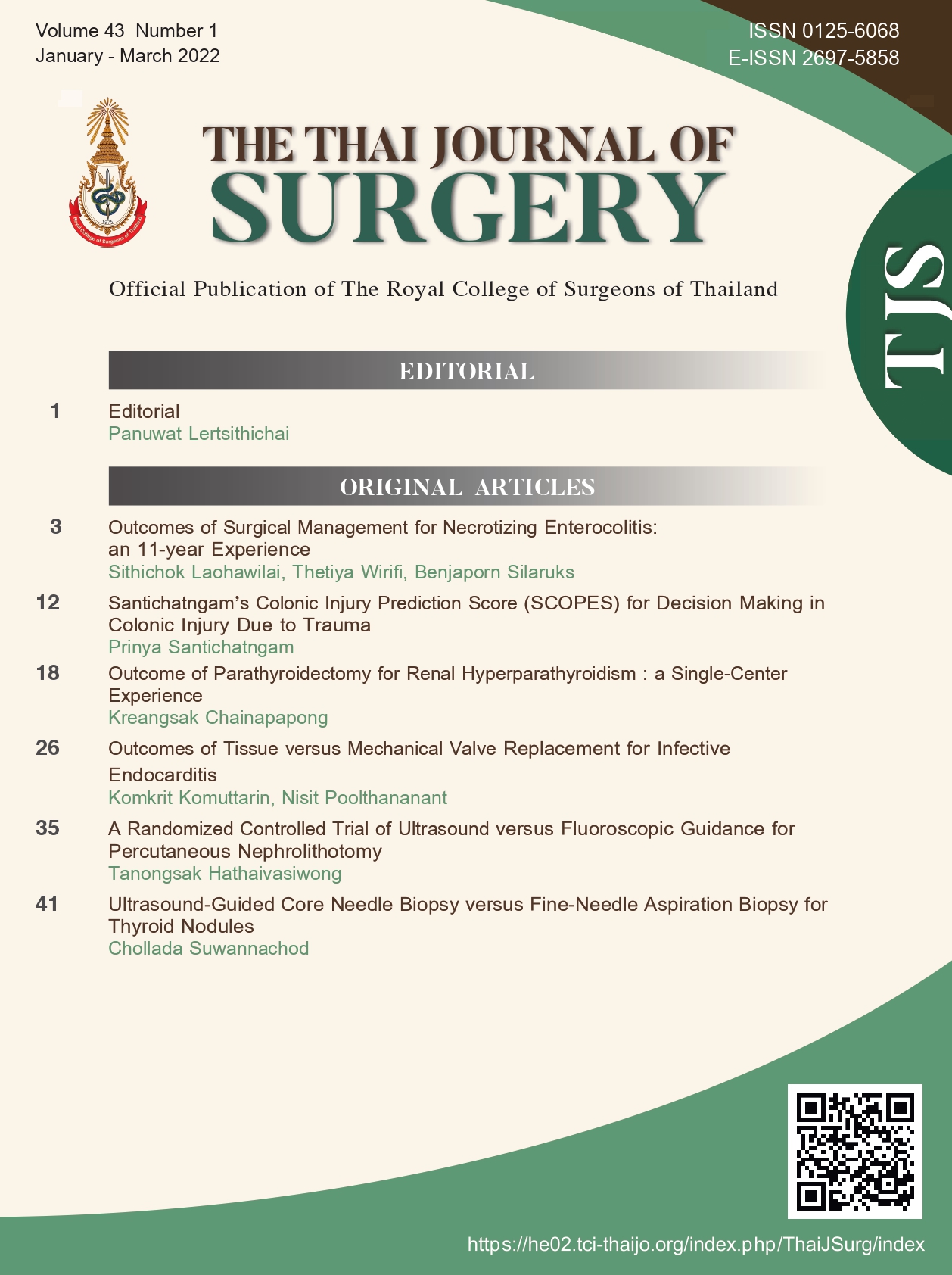Outcomes of Surgical Management for Necrotizing Enterocolitis: an 11-year Experience
Keywords:
Necrotizing enterocolitis, Primary peritoneal drainage, Primary exploratory laparotomy, Necrotic bowel resection, EnterostomyAbstract
Background: Necrotizing enterocolitis (NEC) is a serious disease in neonates and requires surgical treatment in cases with complications. The purpose of this study was to review outcomes of NEC patients treated by various procedures during an 11-year period.
Materials and Methods: A retrospective cohort study of patients with NEC treated at Khon Kaen Hospital between January 2009 and December 2019 was conducted. Medical records of patients were abstracted for clinical characteristics and presentations, laboratory findings, radiologic studies and results of treatment.
Results: Seventy-three NEC patients (40 males and 33 females) was available for the study. Sixty-one cases (84%) were managed by medical treatment and 12 cases (16.4%) required surgery because of complications due to intestinal perforation and peritonitis. Of the 12 surgical NEC, 10 cases (83%) were premature (median gestational age, 29 weeks) and 10 were low birth weight infants (median birth weight, 1263 grams). Nine cases (75%) had a serious condition treated by primary peritoneal drainage (PPD) and 4 cases survived (44%). Three cases underwent primary exploratory laparotomy (PEL) – 2 had necrotic bowel resection with enterostomy, and one had primary anastomosis – and only one survived. The overall mortality of surgical NEC was 60% (7 of 12 cases), and the mortality rate of medical NEC was 12% (7 of 61 cases).
Conclusion: NEC patients with serious complications including intestinal perforation and peritonitis require surgical treatment. PPD was done more common than PEL because of severely – ill patients with extremely and very low birth weight. The overall mortality of surgical NEC remains high, at 50%.
References
Fitzgibbons SC, Ching Y, Yu D, et al. Mortality of necrotizing enterocolitis expressed by birth weight categories. J Pediatr Surg 2009;44:1072-6.
Stoll BJ, Hansen NI, Bell EF, et al. Trends in care practices, morbidity, and mortality of extremely preterm neonates, 1993-2012. JAMA 2015;314:1039-51.
Toulukian RJ. Neonatal necrotizing enterocolitis: an update on etiology, diagnosis and treatment. Surg Clin North Am 1976;56:281-98.
Kliegman RM, Famaroff AA. Necrotizing enterocolitis. N Engl J Med 1984;310:1093-103.
Balance WA, Dahms BB, Shenker N, et al. Pathology of neonatal necrotizing enterocolitis: a ten-year experience. J Pediatr 1990;117:S6-13.
Neu J. Necrotizing enterocolitis: the search for a unifying pathogenic theory leading to prevention. Pediatr Clin North Am 1996;42:409-32.
Bell MI, Ternberg JL, Feigin RD, et al. Neonatal necrotizing enterocolitis. Therapeutic decision based on clinical staging. Ann Surg 1978;187:1-7.
Walsh MC, Kleigman RM. Necrotizing enterocolitis: treatment based on staging criteria. Pediatr Clin North Am 1986;33:179-201.
Holman RC, Stoll BJ, Curns AT, et al. Necrotizing enterocolitis hospitalizations among neonates in the United States. Pediatr Perinat Epidemiol 2006;20:498-506.
Rees CM, Eaton S, Pierro A. National prospective surveillance study of necrotizing enterocolitis in neonatal intensive care units. J Pediatr Surg 2010;45:1391-7.
Chotikiat U. Risk factors of necrotizing enterocolitis (NEC). Prog Pediatr J 1997;4:7-13 (in Thai).
Sritarachiyanon C. Risks factors for necrotizing enterocolitis in preterm neonates. Submitted in partial fulfillment of the requirement for the Diploma of Thai Board of Pediatrics of the Medical Council 2003 (in Thai).
Strategy and Planning Division (SPD), The Ministry of Public Health (MOPH). Thailand Health Profile 2001-2004, http://bps.moph.go.th/new_bps/thailand_health_profile/Thailand%20Health%20Profile%20Report%202001-2004.pdf (Accessed on January 26, 2021).
Khomnuan Y, Niramis R, Tongsin A, et al. Necrotizing enterocolitis: an 8-year experience with 60 surgical patients. Thai J Pediatr 2013;20:13-19 (in Thai).
Sharma R, Tepas JJ 3rd, Wludyka PS, et al. Impact of gestational age on the clinical presentation of necrotizing enterocolitis. J Perinatal 2006;26:342-7.
Hull MA, Fisher JG, Gutherrez IM, et al. Mortality and management of surgical necrotizing enterocolitis in very low birth weight neonates: a prospective cohort study. J Am Coll Surg 2014;218:1148-55.
Kosloske AM. Indications for operation in necrotizing enterocolitis revisited. J Pediatr Surg 1994;29:663-6.
Munaco AJ, Veenstra MA, Brownie E, et al. Timing of optimal surgical intervention for neonates with necrotizing enterocolitis. Am Surg 2015;81:438-43.
Robinson JR, Rellinger EJ, Hatch LD, et al. Surgical necrotizing enterocolitis. Semin Perinatal 2017;41:41-70.
Ein SH, Mashall DG, Girvan D. Peritoneal drainage under local anesthesia for perforations from necrotizing enterocolitis. J Pediatr Surg 1977;12:963-7.
Cheu HW, Sukarochana K, Lloyd DA. Peritoneal drainage for necrotizing enterocolitis. J Pediatr Surg 1988;23:557-61.
Dominguez KM, Moss RL. Necrotizing enterocolitis. In: Holmcomb GW III, Murphy JP, St. Peter SD, eds. Holcomb and Ashcraft’s Pediatric Surgery. 7thed. New York: Elsevier; 2020:536-56.
Moore TC. The management of necrotizing enterocolitis by “patch, drain, and wait”. Pediatr Surg Int 1989;4:110-3.
Vaughan WG, Grosfeld JL, West K, et al. Avoidance of stoma and delayed anastomosis for bowel necrosis: the “clip and drop back” technique. J Pediatr Surg 1996;31:542-5.
Guthric SO, Gordon PV, Thomas V, et al. Necrotizing enterocolitis among neonates in the United States. J Perinatol 2003;23:278-85.
Blakely ML, Gupta H, Lally KP. Surgical management of enterocolitis and isolated intestinal perforation in premature neonates. Semin Perinatol 2008;32:122-6.
Abdullah F, Zhang Y, Camp M, et al. Necrotizing enterocolitis in 20,822 infants: analysis of medical and surgical treatments. Clin Pediatr 2010;49:166-71.
Downloads
Published
How to Cite
Issue
Section
License
Copyright (c) 2022 The Royal College of Surgeons of Thailand

This work is licensed under a Creative Commons Attribution-NonCommercial-NoDerivatives 4.0 International License.
Articles must be contributed solely to The Thai Journal of Surgery and when published become the property of the Royal College of Surgeons of Thailand. The Royal College of Surgeons of Thailand reserves copyright on all published materials and such materials may not be reproduced in any form without the written permission.



